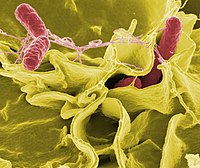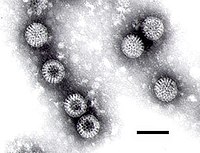| Food allergy | |
|---|---|
 | |
| Hives on the back are a common allergy symptom. | |
| Specialty | Emergency medicine |
| Symptoms | Itchiness, swelling of the tongue, vomiting, diarrhea, hives, trouble breathing, low blood pressure |
| Usual onset | Minutes to several hours of exposure |
| Duration | Long term, some may resolve |
| Causes | Immune response to food |
| Risk factors | Family history, vitamin D deficiency, obesity, high levels of cleanliness |
| Diagnostic method | Based on a medical history, elimination diet, skin prick test, oral food challenge |
| Differential diagnosis | Food intolerance, celiac disease, food poisoning |
| Prevention | Early exposure to potential allergens |
| Treatment | Avoiding the food in question, having a plan if exposure occurs, medical alert jewelry |
| Medication | Adrenaline (epinephrine) |
| Frequency | ~6% (developed world) |
A food allergy is an abnormal immune response to food. The symptoms of the allergic reaction may range from mild to severe. They may include itchiness, swelling of the tongue, vomiting, diarrhea, hives, trouble breathing, or low blood pressure. This typically occurs within minutes to several hours of exposure. When the symptoms are severe, it is known as anaphylaxis. A food intolerance and food poisoning are separate conditions, not due to an immune response.
Common foods involved include cow's milk, peanuts, eggs, shellfish, fish, tree nuts, soy, wheat, rice, and fruit. The common allergies vary depending on the country. Risk factors include a family history of allergies, vitamin D deficiency, obesity, and high levels of cleanliness. Allergies occur when immunoglobulin E (IgE), part of the body's immune system, binds to food molecules. A protein in the food is usually the problem. This triggers the release of inflammatory chemicals such as histamine. Diagnosis is usually based on a medical history, elimination diet, skin prick test, blood tests for food-specific IgE antibodies, or oral food challenge.
Early exposure to potential allergens may be protective. Management primarily involves avoiding the food in question and having a plan if exposure occurs. This plan may include giving adrenaline (epinephrine) and wearing medical alert jewelry. The benefits of allergen immunotherapy for food allergies is unclear, thus is not recommended as of 2015. Some types of food allergies among children resolve with age, including that to milk, eggs, and soy; while others such as to nuts and shellfish typically do not.
In the developed world, about 4% to 8% of people have at least one food allergy. They are more common in children than adults and appear to be increasing in frequency. Male children appear to be more commonly affected than females. Some allergies more commonly develop early in life, while others typically develop in later life. In developed countries, a large proportion of people believe they have food allergies when they actually do not have them. The declaration of the presence of trace amounts of allergens in foods is mandatory only in Brazil.
Signs and symptoms
Food allergies usually have a fast onset (from seconds to one hour) and may include:
- Rash
- Hives
- Itching of mouth, lips, tongue, throat, eyes, skin, or other areas
- Swelling (angioedema) of lips, tongue, eyelids, or the whole face
- Difficulty swallowing
- Runny or congested nose
- Hoarse voice
- Wheezing and/or shortness of breath
- Diarrhea, abdominal pain, and/or stomach cramps
- Lightheadedness
- Fainting
- Nausea
- Vomiting
In some cases, however, onset of symptoms may be delayed for hours.
Symptoms can vary. The amount of food needed to trigger a reaction also varies.
Serious danger regarding allergies can begin when the respiratory
tract or blood circulation is affected. The former can be indicated
through wheezing and cyanosis. Poor blood circulation leads to a weak pulse, pale skin and fainting.
A severe case of an allergic reaction, caused by symptoms affecting the respiratory tract and blood circulation, is called anaphylaxis. When symptoms are related to a drop in blood pressure, the person is said to be in anaphylactic shock. Anaphylaxis occurs when IgE antibodies are involved, and areas of the body that are not in direct contact with the food become affected and show symptoms. Those with asthma or an allergy to peanuts, tree nuts, or seafood are at greater risk for anaphylaxis.
Cause
Although sensitivity levels vary by country, the most common food allergies are allergies to milk, eggs, peanuts, tree nuts, seafood, shellfish, soy, and wheat. These are often referred to as "the big eight". Allergies to seeds — especially sesame — seem to be increasing in many countries. An example an allergy more common to a particular region is that to rice in East Asia where it forms a large part of the diet.
One of the most common food allergies is a sensitivity to peanuts, a member of the bean family. Peanut allergies may be severe, but children with peanut allergies sometimes outgrow them. Tree nuts, including almonds, brazil nuts, cashews, coconuts, hazelnuts, macadamia nuts, pecans, pistachios, pine nuts, and walnuts, are also common allergens. Sufferers may be sensitive to one particular tree nut or to many different ones. Also, seeds, including sesame seeds and poppy seeds, contain oils where protein is present, which may elicit an allergic reaction.
Egg allergies affect about one in 50 children but are frequently outgrown by children when they reach age five. Typically, the sensitivity is to proteins in the white, rather than the yolk.
Milk from cows, goats, or sheep is another common food allergen,
and many sufferers are also unable to tolerate dairy products such as
cheese. A small portion of children with a milk allergy, roughly 10%, have a reaction to beef. Beef contains a small amount of protein that is also present in cow's milk.
Seafood is one of the most common sources of food allergens; people may be allergic to proteins found in fish, crustaceans, or shellfish.
Other foods containing allergenic proteins include soy, wheat, fruits, vegetables, maize, spices, synthetic and natural colors, and chemical additives.
Balsam of Peru,
which is in various foods, is in the "top five" allergens most commonly
causing patch test reactions in people referred to dermatology clinics.
Sensitization
Sensitization can occur through the gastrointestinal tract, respiratory tract and possibly the skin. Damage to the skin in conditions such as eczema has been proposed as a risk factor for sensitization. An Institute of Medicine report says that food proteins contained in vaccines, such as gelatin, milk, or egg can cause sensitization (development of allergy) in vaccine recipients, to those food items.
Atopy
Food allergies develop more easily in people with the atopic syndrome, a very common combination of diseases: allergic rhinitis and conjunctivitis, eczema, and asthma. The syndrome has a strong inherited component; a family history of allergic diseases can be indicative of the atopic syndrome.
Cross-reactivity
Some children who are allergic to cow's milk protein also show a cross-sensitivity to soy-based products. Some infant formulas have their milk and soy proteins hydrolyzed, so when taken by infants, their immune systems
do not recognize the allergen and they can safely consume the product.
Hypoallergenic infant formulas can be based on proteins partially
predigested to a less antigenic form. Other formulas, based on free
amino acids, are the least antigenic and provide complete nutritional
support in severe forms of milk allergy.
People with latex allergy often also develop allergies to bananas, kiwifruit, avocados, and some other foods.
Pathophysiology
Histamine, the structure shown, causes a person to feel itchy during an allergic reaction.
Conditions caused by food allergies are classified into three groups according to the mechanism of the allergic response:
- IgE-mediated (classic) – the most common type, occurs shortly after eating and may involve anaphylaxis.
- Non-IgE mediated – characterized by an immune response not involving immunoglobulin E; may occur some hours after eating, complicating diagnosis
- IgE and/or non-IgE-mediated – a hybrid of the above two types
Allergic reactions
are hyperactive responses of the immune system to generally innocuous
substances. When immune cells encounter the allergenic protein, IgE
antibodies are produced; this is similar to the immune system's reaction
to foreign pathogens.
The IgE antibodies identify the allergenic proteins as harmful and
initiate the allergic reaction. The harmful proteins are those that do
not break down due to the strong bonds of the protein. IgE antibodies
bind to a receptor on the surface of the protein, creating a tag, just
as a virus or parasite becomes tagged. Why some proteins do not denature
and subsequently trigger allergic reactions and hypersensitivity while
others do is not entirely clear.
Hypersensitivities are categorized according to the parts of the
immune system that are attacked and the amount of time it takes for the
response to occur. The four types of hypersensitivity reaction are: type 1, immediate IgE-mediated; type 2, cytotoxic; type 3, immune complex-mediated; and type 4, delayed cell-mediated. The pathophysiology of allergic responses can be divided into two phases. The first is an acute response
that occurs immediately after exposure to an allergen. This phase can
either subside or progress into a "late-phase reaction" which can
substantially prolong the symptoms of a response, and result in tissue
damage.
Many food allergies are caused by hypersensitivities to
particular proteins in different foods. Proteins have unique properties
that allow them to become allergens, such as stabilizing forces in
their tertiary and quaternary structures which prevent degradation
during digestion. Many theoretically allergenic proteins cannot survive
the destructive environment of the digestive tract, thus do not trigger
hypersensitive reactions.
Acute response
In the early stages of allergy, a type I hypersensitivity reaction
against an allergen, encountered for the first time, causes a response
in a type of immune cell called a TH2 lymphocyte, which belongs to a subset of T cells that produce a cytokine called interleukin-4 (IL-4). These TH2 cells interact with other lymphocytes called B cells,
whose role is the production of antibodies. Coupled with signals
provided by IL-4, this interaction stimulates the B cell to begin
production of a large amount of a particular type of antibody known as
IgE. Secreted IgE circulates in the blood and binds to an IgE-specific
receptor (a kind of Fc receptor called FcεRI) on the surface of other kinds of immune cells called mast cells and basophils,
which are both involved in the acute inflammatory response. The
IgE-coated cells, at this stage, are sensitized to the allergen.
If later exposure to the same allergen occurs, the allergen can
bind to the IgE molecules held on the surface of the mast cells or
basophils. Cross-linking of the IgE and Fc receptors occurs when more
than one IgE-receptor complex interacts with the same allergenic
molecule, and activates the sensitized cell. Activated mast cells and
basophils undergo a process called degranulation, during which they release histamine and other inflammatory chemical mediators (cytokines, interleukins, leukotrienes, and prostaglandins) from their granules into the surrounding tissue causing several systemic effects, such as vasodilation, mucous secretion, nerve stimulation, and smooth-muscle contraction. This results in rhinorrhea, itchiness, dyspnea, and anaphylaxis.
Depending on the individual, the allergen, and the mode of
introduction, the symptoms can be system-wide (classical anaphylaxis),
or localized to particular body systems.
Late-phase response
After the chemical mediators of the acute response subside, late-phase responses can often occur due to the migration of other leukocytes such as neutrophils, lymphocytes, eosinophils, and macrophages to the initial site. The reaction is usually seen 2–24 hours after the original reaction. Cytokines from mast cells may also play a role in the persistence of long-term effects.
Diagnosis
Skin testing on the arm is a common way for detecting an allergy, but it is not as effective as other tests.
Diagnosis is usually based on a medical history, elimination diet, skin prick test, blood tests for food-specific IgE antibodies, or oral food challenge.
- For skin-prick tests, a tiny board with protruding needles is used. The allergens are placed either on the board or directly on the skin. The board is then placed on the skin, to puncture the skin and for the allergens to enter the body. If a hive appears, the person is considered positive for the allergy. This test only works for IgE antibodies. Allergic reactions caused by other antibodies cannot be detected through skin-prick tests.
Skin-prick testing is easy to do and results are available in
minutes. Different allergists may use different devices for testing.
Some use a "bifurcated needle",
which looks like a fork with two prongs. Others use a "multitest",
which may look like a small board with several pins sticking out of it.
In these tests, a tiny amount of the suspected allergen is put onto the
skin or into a testing device, and the device is placed on the skin to
prick, or break through, the top layer of skin. This puts a small amount
of the allergen under the skin. A hive will form at any spot where the
person is allergic. This test generally yields a positive or negative
result. It is good for quickly learning if a person is allergic to a
particular food or not, because it detects IgE. Skin tests cannot
predict if a reaction would occur or what kind of reaction might occur
if a person ingests that particular allergen. They can, however, confirm
an allergy in light of a patient's history of reactions to a particular
food. Non-IgE-mediated allergies cannot be detected by this method.
- Patch testing is used to determine if a specific substance causes allergic inflammation of the skin. It tests for delayed food reactions.
- Blood testing is another way to test for allergies; however, it poses the same disadvantage and only detects IgE allergens and does not work for every possible allergen. Radioallergosorbent testing (RAST) is used to detect IgE antibodies present to a certain allergen. The score taken from the RAST is compared to predictive values, taken from a specific type of RAST. If the score is higher than the predictive values, a great chance the allergy is present in the person exists. One advantage of this test is that it can test many allergens at one time.
A CAP-RAST has greater specificity than RAST; it can show the amount of IgE present to each allergen.
Researchers have been able to determine "predictive values" for certain
foods, which can be compared to the RAST results. If a person's RAST
score is higher than the predictive value for that food, over a 95%
chance exists that patients will have an allergic reaction (limited to
rash and anaphylaxis reactions) if they ingest that food. Currently, predictive values are available for milk, egg, peanut, fish, soy, and wheat.
Blood tests allow for hundreds of allergens to be screened from a
single sample, and cover food allergies as well as inhalants. However,
non-IgE-mediated allergies cannot be detected by this method. Other
widely promoted tests such as the antigen leukocyte cellular antibody test and the food allergy profile are considered unproven methods, the use of which is not advised.
- Food challenges test for allergens other than those caused by IgE allergens. The allergen is given to the person in the form of a pill, so the person can ingest the allergen directly. The person is watched for signs and symptoms. The problem with food challenges is that they must be performed in the hospital under careful watch, due to the possibility of anaphylaxis.
Food challenges, especially double-blind,
placebo-controlled food challenges, are the gold standard for diagnosis
of food allergies, including most non-IgE-mediated reactions, but is
rarely done.
Blind food challenges involve packaging the suspected allergen into a
capsule, giving it to the patient, and observing the patient for signs
or symptoms of an allergic reaction.
The recommended method for diagnosing food allergy is to be
assessed by an allergist. The allergist will review the patient's
history and the symptoms or reactions that have been noted after food
ingestion. If the allergist feels the symptoms or reactions are
consistent with food allergy, he/she will perform allergy tests.
Additional diagnostic tools for evaluation of eosinophilic or non-IgE
mediated reactions include endoscopy, colonoscopy, and biopsy.
Differential diagnosis
Important differential diagnoses are:
- Lactose intolerance generally develops later in life, but can present in young patients in severe cases. It is due to an enzyme deficiency (lactase) and not allergy, and occurs in many non-Western people.
- Celiac disease. While it is caused by a permanent intolerance to gluten (present in wheat, rye, barley and oats), is not an allergy nor simply an intolerance, but a chronic, multiple-organ autoimmune disorder primarily affecting the small intestine.
- Irritable bowel syndrome
- C1 Esterase inhibitor deficiency (hereditary angioedema), a rare disease, generally causes attacks of angioedema, but can present solely with abdominal pain and occasional diarrhea.
Prevention
Breastfeeding for more than four months may prevent atopic dermatitis, cow's milk allergy, and wheezing in early childhood. Early exposure to potential allergens may be protective. Specifically, early exposure to eggs and peanuts reduces the risk of allergies to these. Guidelines suggest introducing peanuts as early as 4–6 months and include precautionary measures for high-risk infants.[59] The former guidelines, advising delaying the introduction of peanuts, are now thought to have contributed to the increase in peanut allergy seen recently.
To avoid an allergic reaction, a strict diet can be followed. It
is difficult to determine the amount of allergenic food required to
elicit a reaction, so complete avoidance should be attempted. In some
cases, hypersensitive reactions can be triggered by exposures to
allergens through skin contact, inhalation, kissing, participation in
sports, blood transfusions, cosmetics, and alcohol.
Inhalation exposure
Allergic
reactions to airborne particles or vapors of known food allergens have
been reported as an occupational consequence of people working in the
food industry, but can also take place in home situations, restaurants,
or confined spaces such as airplanes. According to two reviews,
respiratory symptoms are common, but in some cases there has been
progression to anaphylaxis.
The most frequent reported cases of reactions by inhalation of
allergenic foods were due to peanut, seafood, legumes, tree nut, and
cow's milk.
Steam rising from cooking of lentils, green beans, chickpeas and fish
has been well documented as triggering reactions, including anaphylactic
reactions.
One review mentioned case study examples of allergic responses to
inhalation of other foods, including examples in which oral consumption
of the food is tolerated.
Treatment
The
mainstay of treatment for food allergy is total avoidance of the foods
identified as allergens. An allergen can enter the body by consuming a
food containing the allergen, and can also be ingested by touching any
surfaces that may have come into contact with the allergen, then
touching the eyes or nose. For people who are extremely sensitive,
avoidance includes avoiding touching or inhaling the problematic food.
Total avoidance is complicated because the declaration of the presence
of trace amounts of allergens in foods is not mandatory.
If the food is accidentally ingested and a systemic reaction (anaphylaxis) occurs, then epinephrine
should be used. A second dose of epinephrine may be required for severe
reactions. The person should then be transported to the emergency room, where additional treatment can be given. Other treatments include antihistamines and steroids.
Epinephrine
Epinephrine autoinjectors are portable single-dose epinephrine-dispensing devices used to treat anaphylaxis.
Epinephrine
(adrenaline) is the first-line treatment for severe allergic reactions
(anaphylaxis). If administered in a timely manner, epinephrine can
reverse its effects. Epinephrine relieves airway swelling and
obstruction, and improves blood circulation; blood vessels are tightened
and heart rate is increased, improving circulation to body organs.
Epinephrine is available by prescription in an autoinjector.
Antihistamines
Antihistamines can alleviate some of the milder symptoms of an allergic reaction, but do not treat all symptoms of anaphylaxis. Antihistamines block the action of histamine,
which causes blood vessels to dilate and become leaky to plasma
proteins. Histamine also causes itchiness by acting on sensory nerve
terminals. The most common antihistamine given for food allergies is diphenhydramine.
Steroids
Glucocorticoid steroids
are used to calm down the immune system cells that are attacked by the
chemicals released during an allergic reaction. This treatment in the
form of a nasal spray
should not be used to treat anaphylaxis, for it only relieves symptoms
in the area in which the steroid is in contact. Another reason steroids
should not be used is the delay in reducing inflammation. Steroids can
also be taken orally or through injection, by which every part of the
body can be reached and treated, but a long time is usually needed for
these to take effect.
Epidemiology
The most common food allergens account for about 90% of all allergic reactions; in adults they include shellfish, peanuts, tree nuts, fish, and egg. In children, they include milk, eggs, peanuts, and tree nuts. Six to 8% of children under the age of three have food allergies and nearly 4% of adults have food allergies.
For reasons not entirely understood, the diagnosis of food
allergies has apparently become more common in Western nations recently. One possible explanation for this is the "old friends" hypothesis which suggests that non disease causing organisms, such as helminths,
could protect against allergy. Therefore, reduced exposure to these
organisms, particularly in developed countries, could have contributed
towards the increase.
In the United States, food allergy affects as many as 5% of infants less than three years of age and 3% to 4% of adults. A similar prevalence is found in Canada.
About 75% of children who have allergies to milk protein are able
to tolerate baked-in milk products, i.e., muffins, cookies, cake, and
hydrolyzed formulas.
About 50% of children with allergies to milk, egg, soy, peanuts,
tree nuts, and wheat will outgrow their allergy by the age of 6. Those
who are still allergic by the age of 12 or so have less than an 8%
chance of outgrowing the allergy.
Peanut and tree nut allergies are less likely to be outgrown, although evidence now[when?] shows[78] that about 20% of those with peanut allergies and 9% of those with tree nut allergies will outgrow them.
In Japan, allergy to buckwheat flour, used for soba noodles, is more common than peanuts, tree nuts or foods made from soy beans.
United States
In
the United States, an estimated 12 million people have food allergies.
Food allergy affects as many as 5% of infants less than three years of
age and 3% to 4% of adults. The prevalence of food allergies is rising. Food allergies cause roughly 30,000 emergency room visits and 150 deaths per year.
Society and culture
Whether
rates of food allergy are increasing or not, food allergy awareness has
definitely increased, with impacts on the quality of life for children,
their parents and their caregivers.
In the United States, the Food Allergen Labeling and Consumer
Protection Act of 2004 causes people to be reminded of allergy problems
every time they handle a food package, and restaurants have added
allergen warnings to menus. The Culinary Institute of America, a premier
school for chef training, has courses in allergen-free cooking and a
separate teaching kitchen.
School systems have protocols about what foods can be brought into the
school. Despite all these precautions, people with serious allergies are
aware that accidental exposure can easily occur at other peoples'
houses, at school or in restaurants. Food fear has a significant impact on quality of life.
For children with allergies, their quality of life is also affected by
actions of their peers. There is an increased occurrence of bullying,
which can include threats or acts of deliberately being touched with
foods they need to avoid, also having their allergen-free food
deliberately contaminated. In the 2018 animated/live action movie Peter Rabbit,
rabbits used blackberries to deliberately induce an anaphylactic
allergy response in a farmer who is trying to protect his garden. After
many public protests, Sony Pictures and the director apologized for
making light of food allergies.
Regulation of labelling
An example of a list of allergens in a food item
In response to the risk that certain foods pose to those with food
allergies, some countries have responded by instituting labeling laws
that require food products to clearly inform consumers if their products
contain priority allergens or byproducts of major allergens among the
ingredients intentionally added to foods.
The priority allergens vary by country.
There are no labeling laws mandating declaration of the presence of
trace amounts in the final product as a consequence of
cross-contamination, except in Brazil.
Ingredients intentionally added
In the United States, the Food Allergen Labeling and Consumer Protection Act
of 2004 (FALCPA) requires companies to disclose on the label whether a
packaged food product contains any of these eight major food allergens,
added intentionally: cow's milk, peanuts, eggs, shellfish, fish, tree
nuts, soy and wheat. (In October 2018 the US FDA
issued a request for information for the consideration of labeling for
sesame to help protect people who have sesame allergies.) The eight-ingredient is list originated in 1999 from the World Health Organisation Codex Alimentarius Commission.
To meet FALCPA labeling requirements, if an ingredient is derived from
one of the required-label allergens, then it must either have its "food
sourced name" in parentheses, for example "Casein (milk)," or as an
alternative, there must be a statement separate but adjacent to the
ingredients list: "Contains milk" (and any other of the allergens with
mandatory labeling). The European Union requires listing for those eight major allergens plus molluscs, celery, mustard, lupin, sesame and sulfites.
FALCPA applies to packaged foods regulated by the FDA, which does
not include poultry, most meats, certain egg products, and most
alcoholic beverages.
However, some meat, poultry, and egg processed products may contain
allergenic ingredients. These products are regulated by the Food Safety and Inspection Service
(FSIS), which requires that any ingredient be declared in the labeling
only by its common or usual name. Neither the identification of the
source of a specific ingredient in a parenthetical statement nor the use
of statements to alert for the presence of specific ingredients, like
"Contains: milk", are mandatory according to FSIS. FALCPA also does not apply to food prepared in restaurants.
The EU Food Information for Consumers Regulation 1169/2011 – requires
food businesses to provide allergy information on food sold unpackaged,
for example, in catering outlets, deli counters, bakeries and sandwich
bars.
In the United States, there is no federal mandate to address the
presence of allergens in drug products. FALCPA does not apply to
medicines nor to cosmetics.
Trace amounts as a result of cross-contamination
The
value of allergen labeling other than for intentional ingredients is
controversial. This concerns labeling for ingredients present
unintentionally as a consequence of cross-contact or cross-contamination
at any point along the food chain (during raw material transportation,
storage or handling, due to shared equipment for processing and
packaging, etc.).
Experts in this field propose that if allergen labeling is to be useful
to consumers, and healthcare professionals who advise and treat those
consumers, ideally there should be agreement on which foods require
labeling, threshold quantities below which labeling may be of no
purpose, and validation of allergen detection methods to test and
potentially recall foods that were deliberately or inadvertently
contaminated.
Labeling regulations have been modified to provide for mandatory
labeling of ingredients plus voluntary labeling, termed precautionary
allergen labeling (PAL), also known as “may contain” statements, for
possible, inadvertent, trace amount, cross-contamination during
production. PAL labeling can be confusing to consumers, especially as there can be many variations on the wording of the warning. PAL is optional in the United States. As of 2014,
PAL is regulated only in Switzerland, Japan, Argentina, and South
Africa. Argentina decided to prohibit precautionary allergen labeling
since 2010, and instead puts the onus on the manufacturer to control the
manufacturing process and label only those allergenic ingredients known
to be in the products. South Africa does not permit the use of PAL,
except when manufacturers demonstrate the potential presence of allergen
due to cross-contamination through a documented risk assessment and
despite adherence to Good Manufacturing Practice.
In Australia and New Zealand there is a recommendation that PAL be
replaced by guidance from VITAL 2.0 (Vital Incidental Trace Allergen
Labeling). A review identified "the eliciting dose for an allergic
reaction in 1% of the population" as ED01. This threshold reference dose
for foods (such as cow's milk, egg, peanut and other proteins) will
provide food manufacturers with guidance for developing precautionary
labeling and give consumers a better idea of might be accidentally in a
food product beyond "may contain." VITAL 2.0 was developed by the Allergen Bureau, a food industry sponsored, non-government organization.
The European Union has initiated a process to create labeling
regulations for unintentional contamination but is not expected to
publish such before 2024.
In Brazil, since April 2016, the declaration of the possibility
of cross-contamination is mandatory when the product does not
intentionally add any allergenic food or its derivatives, but the Good
Manufacturing Practices and allergen control measures adopted are not
sufficient to prevent the presence of accidental trace amounts. These
allergens include wheat, rye, barley, oats and their hybrids,
crustaceans, eggs, fish, peanuts, soybean, milk of all species of
mammalians, almonds, hazelnuts, cashew nuts, Brazil nuts, macadamia nuts, walnuts, pecan nuts, pistachios, pine nuts, and chestnuts.
Genetically modified food
There are concerns that genetically modified foods, also described as foods sourced from genetically modified organisms
(GMO), could be responsible for allergic reactions, and that the
widespread acceptance of GMO foods may be responsible for what is a real
or perceived increase in the percentage of people with allergies. There is a scientific consensus that available food derived from GM crops poses no greater risk to human health than conventional food. A 2016 U.S. National Academy of Sciences
report concluded that there is no relationship between consumption of
GM foods and the increase in prevalence of food allergies.
One concern is that genetic engineering could make an
allergy-provoking food more allergic, meaning that smaller portions
would suffice to set off a reaction. Of the food currently
in widespread GMO use, only soybeans are identified as a common
allergen. However, for the soybean proteins known to trigger allergic
reactions, there is more variation from strain to strain than between
those and the GMO varieties.
Another concern is that genes transferred from one species to another
could introduce an allergen in a food not thought of as particularly
allergenic. Research on an attempt to enhance the quality of soybean
protein by adding genes from Brazil nuts was terminated when human
volunteers known to have tree nut allergy reacted to the modified
soybeans.
Prior to a new GMO food receiving government approval, certain
criteria need to be met. These include: Is the donor species known to be
allergenic? Does the amino acid sequence of the transferred proteins
resemble the sequence of known allergenic proteins? Are the transferred
proteins resistant to digestion - a trait shared by many allergenic
proteins?
Genes approved for animal use can be restricted from human consumption
due to potential for allergic reactions. In 1998 Starlink brand corn
restricted to animals was detected in was found in the human food
supply, leading to first a voluntary and then a FDA mandated recall.
There are requirements in some countries and recommendations in others
that all foods containing GMO ingredients be so labeled, and that there
be a post-launch monitoring system to report adverse effects (much there
exists in some countries for drug and dietary supplement reporting).
Restaurants
In
the US, the FDA Food Code states that the person in charge in
restaurants should have knowledge about major food allergens,
cross-contacts, and symptoms of food allergy
reactions. Restaurant staff, including wait staff and kitchen staff, may
not be adequately informed about allergenic ingredients, or the risk of
cross-contact when kitchen utensils used to prepare food may have been
in previous contact with an allergenic food. The problem may be
compounded when customers have a hard time describing their food
allergies or when wait staff have a hard time understanding those with
food allergies when taking an order.
Diagnosing issues
There
exists both over-reporting and under-reporting of the prevalence of
food allergies. Self-diagnosed perceptions of food allergy are greater
than the rates of true food allergy because people confuse non-allergic
intolerance with allergy, and also attribute non-allergy symptoms to an
allergic response. Conversely, healthcare professionals treating
allergic reactions on an out-patient or even hospitalized basis may not
report all cases. Recent increases in reported cases may reflect a real
change in incidence or an increased awareness on the part of healthcare
professionals.
Research
A number of desensitization techniques are being studied. Areas of research include anti-IgE antibody (omalizumab), specific oral tolerance induction (SOTI, also known as OIT for oral immunotherapy), and sublingual immunotherapy (SLIT). The benefits of allergen immunotherapy for food allergies is unclear, thus is not recommended as of 2015.
There is research on the effects of increasing intake of polyunsaturated fatty acids
(PUFAs) during pregnancy, lactation, via infant formula and in early
childhood on the subsequent risk of developing food allergies during
infancy and childhood. From two reviews, maternal intake of omega-3, long-chain fatty acids
during pregnancy appeared to reduce the risks of medically diagnosed
IgE-mediated allergy, eczema and food allergy per parental reporting in
the first 12 months of life, but the effects were not all sustained past 12 months. The reviews characterized the literature's evidence as inconsistent and limited. Results when breastfeeding mothers were consuming a diet high in PUFAs were inconclusive.
For infants, supplementing their diet with oils high in PUFAs did not
affect the risks of food allergies, eczema or asthma either as infants
or into childhood.
There is research on probiotics, prebiotics and the combination of the two (synbiotics)
as a means of treating or preventing infant and child allergies. From
reviews, there appears to be a treatment benefit for eczema, but not asthma, wheezing or rhinoconjunctivitis. The evidence was not consistent for preventing food allergies and this approach cannot yet be recommended.
The Food Standards Agency, in the United Kingdom, are in charge of funding research into food allergies and intolerance. Since their founding in 1994 they have funded over 45 studies. In 2005 Europe created EuroPrevall, a multi-country project dedicated to research involving allergies.











